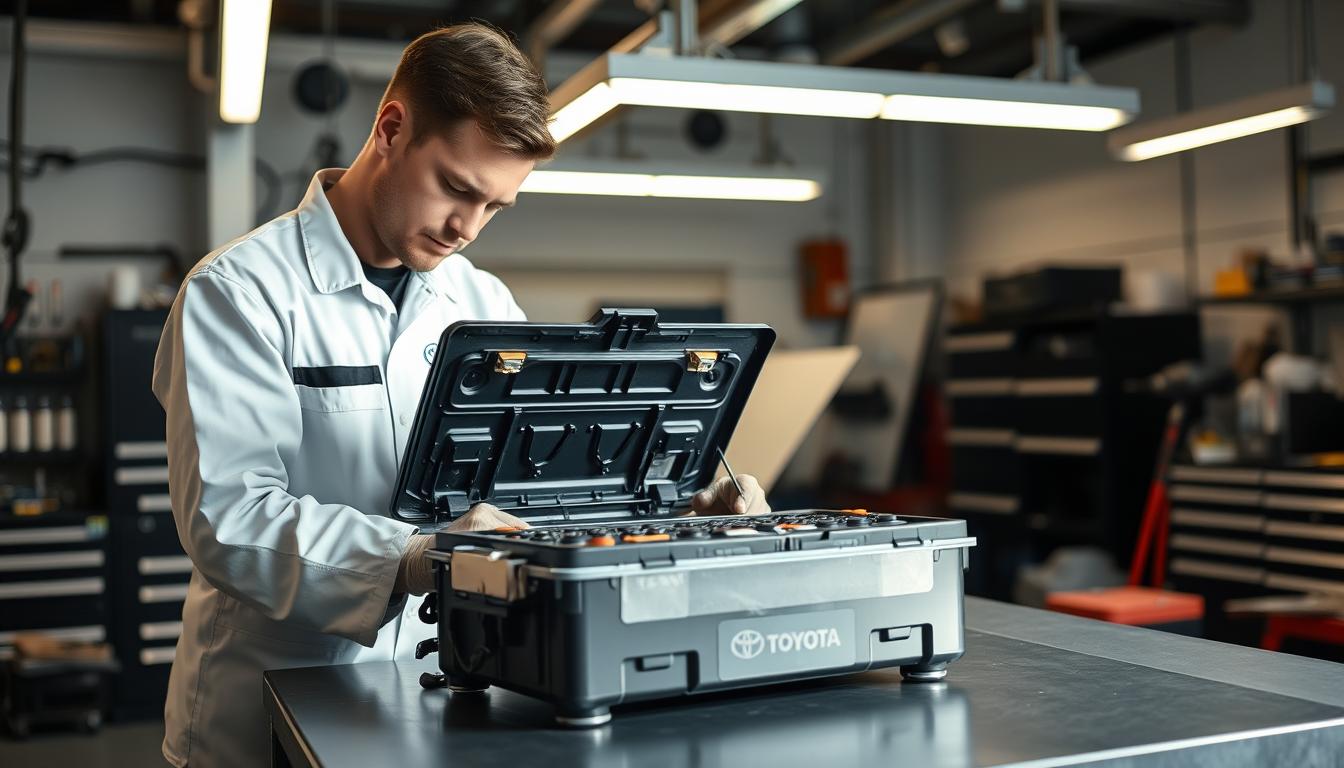Owning an eco-friendly vehicle means you need to take special care of its power system. Proper care of your hybrid power unit can make it last longer and work better for years.
Did you know the Prius is the car owners keep the longest? An amazing 13.7% of Prius owners keep their cars for 15+ years. This is more than double the average for all cars. It shows how well these cars last if you take good care of them.
Knowing how to correctly care for your hybrid car battery is key. It’s important to learn how to charge it right and spot any problems early. This helps keep your eco-friendly car in top shape.
This guide covers everything from the tech behind these power systems to practical maintenance tips to avoid early battery failure. Whether you’re new to hybrid cars or want to keep your current one running well, you’ll find helpful advice here.
Understanding Toyota Hybrid Battery Technology
Learning about Toyota hybrid batteries is key for keeping your car running well. These advanced systems have been improved over the years. They make your car more efficient and reduce emissions.
How Toyota Hybrid Batteries Work
Toyota’s Hybrid Synergy Drive combines electric and gasoline power. This is different from cars that only use gasoline. It makes your car more efficient and cuts down on pollution.
Basic Components and Functions
The Toyota hybrid battery system has several important parts:
- High-voltage battery pack (usually behind the rear seats or under the cargo area)
- Power control unit (PCU) that manages electricity flow
- Inverter system that converts DC to AC power
- Electric motor-generators that provide propulsion and regeneration
- Sophisticated cooling systems to maintain optimal temperature
These parts work together to let your Toyota switch between electric and gasoline power. The battery helps during acceleration and low-speed driving. It also stores energy when you brake.
Energy Flow and Management Systems
Toyota’s hybrid tech is amazing because of its energy management system. When you brake, the electric motor turns into a generator. It turns your car’s motion into electrical energy.
This energy is stored in the battery for later use. The power control unit checks your driving, battery charge, and power needs. It decides the best power source at any time. This smart system helps Toyota hybrids use less fuel.
Different Types of Toyota Hybrid Batteries
Toyota uses two main battery types in their hybrids. Each has its own strengths and weaknesses.
Nickel-Metal Hydride vs. Lithium-Ion
Most Toyota hybrids have one of these two battery types:
- Nickel-Metal Hydride (NiMH): Older models and many current hybrids use these batteries. They are reliable and durable but heavier and less energy-dense than newer options.
- Lithium-Ion: Newer models and plug-in hybrids like the Prius Prime use these batteries. They are lighter and have more energy density, allowing for longer electric-only driving. But they need better cooling systems.
Toyota keeps using NiMH batteries in many models because of their reliability. But they are slowly switching to lithium-ion to improve hybrid tech.
Model-Specific Battery Configurations
Each Toyota hybrid model has its own battery setup:
- The Prius family has a battery pack under the rear seats
- The Camry Hybrid has its battery pack behind the rear seats
- The RAV4 Hybrid has its battery under the rear cargo floor
- The Highlander Hybrid has its battery under the second-row seats
These setups are designed to balance weight, use space well, and keep the battery cool for best performance.
Expected Lifespan of Toyota Hybrid Batteries
With the right care, hybrid battery life in Toyotas can be very long. Most batteries last between 150,000 and 200,000 miles before needing a replacement. Some owners have theirs last even longer with good driving habits and regular maintenance.
Toyota is confident in their hybrid batteries. They offer an 8-year/100,000-mile warranty on hybrid parts, including the battery. In some places with stricter emissions laws, this warranty is longer.
Knowing how Toyota hybrid batteries work helps you take better care of them. By understanding these systems, you can drive smarter and keep your battery running well for a long time.
Signs of Toyota Hybrid Battery Issues
Your Toyota hybrid car can show battery problems in different ways. Spotting these signs early can help avoid costly repairs and breakdowns. Look for changes in how your car acts and check the dashboard lights.
Dashboard Warning Indicators
Your car’s advanced systems can warn you of battery trouble. When your Toyota Prius battery starts to fail, the dashboard lights up.
Check Engine Light Patterns
A steady or flickering check engine light might mean battery cell problems. You might also see a hybrid system warning light. An OBD-II scanner can show error codes like P0A80, which points to battery pack issues.
Battery Management System Alerts
Toyota hybrids have systems that watch over the battery. If they find something off, they’ll alert you on the dashboard. A triangle with an exclamation mark means you need to check the hybrid system right away.
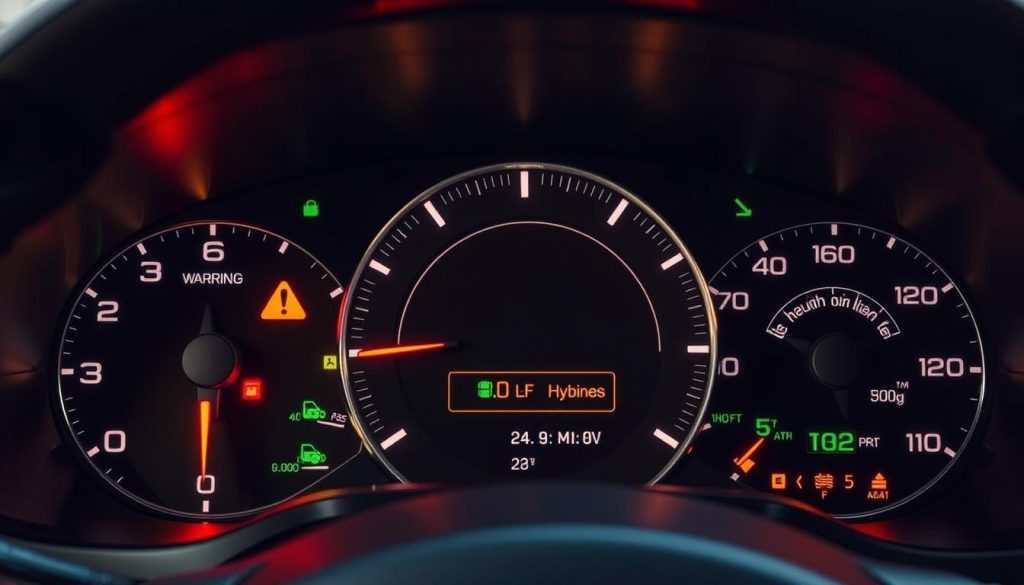
Performance Changes
Even without dashboard lights, your car’s behavior can tell you a lot. If the hybrid car battery is failing, you’ll notice.
Decreased Fuel Economy
A big drop in fuel efficiency is a clear sign of battery trouble. If your MPG falls by 5-10 miles per gallon, it means your engine is working harder. This is because the battery isn’t as strong as it used to be.
Reduced Power and Acceleration
As the battery gets worse, your car will feel slower. It might not go as fast on the highway or climb hills well. This is because the battery can’t give the electric motor the power it needs.
Unusual Noises or Vibrations
A healthy hybrid is quiet. So, any new sounds are a warning. Look out for loud fan noises from the battery cooler or strange sounds from the power inverter.
Feeling vibrations when switching between electric and gas power is another sign. In Prius models, the engine might keep running even when the battery looks full.
If you see these signs, it’s time to check your hybrid battery quickly. Catching problems early can save you from expensive fixes and keep your car running smoothly.
The Toyota Hybrid Battery Maintenance Schedule
Keeping your Toyota hybrid battery in top shape is key. Regular maintenance helps it last longer and work better. By following the manufacturer’s advice and getting regular checks, you can avoid expensive repairs and keep your hybrid running smoothly for years.
Recommended Service Intervals
Toyota suggests checking your hybrid system every 5,000 miles, along with your oil change. These checks are vital to catch problems early.
The Hybrid Health Check program offers special tests for your battery. These tests check all hybrid parts and battery health to make sure everything works right.
A typical maintenance plan for Toyota hybrid batteries includes:
- Every 5,000 miles: Basic hybrid system inspection
- Every 15,000 miles: Thorough battery cooling system check
- Every 30,000 miles: Comprehensive hybrid component inspection
- Every 60,000 miles: In-depth battery pack evaluation
Sticking to this schedule not only extends your Toyota hybrid battery’s life but also keeps your warranty valid. Toyota needs proof of proper maintenance to cover the 8-year/100,000-mile hybrid battery warranty.
Prius-Specific Maintenance
The Prius has its own maintenance needs because of its innovative hybrid design. Regular service for Prius models should include checking the battery cooling system, inspecting the battery pack’s ventilation system, and monitoring cell voltage balance.
Prius owners should watch the battery cooling fan behind the rear seat. This fan prevents overheating and should be cleaned every 30,000 miles to remove dust and debris.
Toyota sometimes releases updates that can improve battery management in Prius models. Getting these updates during regular service can make your battery more efficient and last longer.
Camry and RAV4 Hybrid Maintenance
Camry and RAV4 hybrids have similar maintenance schedules but need some special care. These newer hybrid models have advanced diagnostic tools at dealerships.
The battery cooling systems in these models are different from the Prius. RAV4 and Camry hybrids have an air intake vent under the rear seat that should be kept clear and checked during maintenance.
These models also have advanced battery management systems. Dealer-level diagnostics can ensure they perform at their best. Getting these systems checked every 15,000 miles helps keep them running efficiently.
Professional vs. DIY Maintenance
Some hybrid maintenance tasks you can do at home, but others need special knowledge and tools. Knowing what you can do yourself and when to get professional help is crucial for proper battery care.
Tasks you can do yourself include:
- Cleaning cooling vents and ensuring proper airflow
- Checking for error codes with an OBD-II scanner
- Visual inspection of battery connections
- Monitoring performance metrics through the dashboard display
Professional maintenance offers detailed diagnostics with Toyota-specific tools. Certified technicians can find subtle issues and perform balancing procedures when needed.
For most owners, a mix of DIY and professional maintenance works best. Do basic checks yourself and schedule professional service at recommended times.
Essential Tools for Battery Inspection
If you’re into basic car maintenance, a few specialized tools can help you keep an eye on your Toyota hybrid battery between professional visits.
The most useful tools for hybrid battery inspection include:
- OBD-II scanner with hybrid capabilities – Allows you to read hybrid-specific diagnostic codes and monitor battery performance metrics
- Digital multimeter – Essential for checking voltage levels and identifying potential electrical issues
- Battery cooling system cleaning kit – Helps maintain proper airflow through the battery cooling system
- Insulated gloves and tools – Critical safety equipment when working around high-voltage components
Remember, the hybrid battery system operates at high voltage. Never try to open the battery pack or disconnect high-voltage cables without proper training and equipment.
Regular maintenance with these tools can help spot issues early. But always go to a professional for any battery concerns or when dashboard warning lights come on.
Proper Charging Techniques for Toyota Hybrid Vehicles
To make your Toyota hybrid battery last longer, follow the right charging steps. The correct way to charge can extend your Toyota Hybrid Battery life. It also keeps your car running efficiently for years.
Optimal Charging Patterns
Each Toyota hybrid model needs its own charging method. Knowing these patterns helps you get the best from your hybrid car.
Plug-in Hybrid Charging Best Practices
For cars like Prius Prime and RAV4 Prime, timing is key. Charge during off-peak hours, like at night, to save money and reduce strain on the grid.
Keep your battery between 20% and 80% charged. This range is best for your battery’s health. It reduces stress on the cells and makes them last longer.
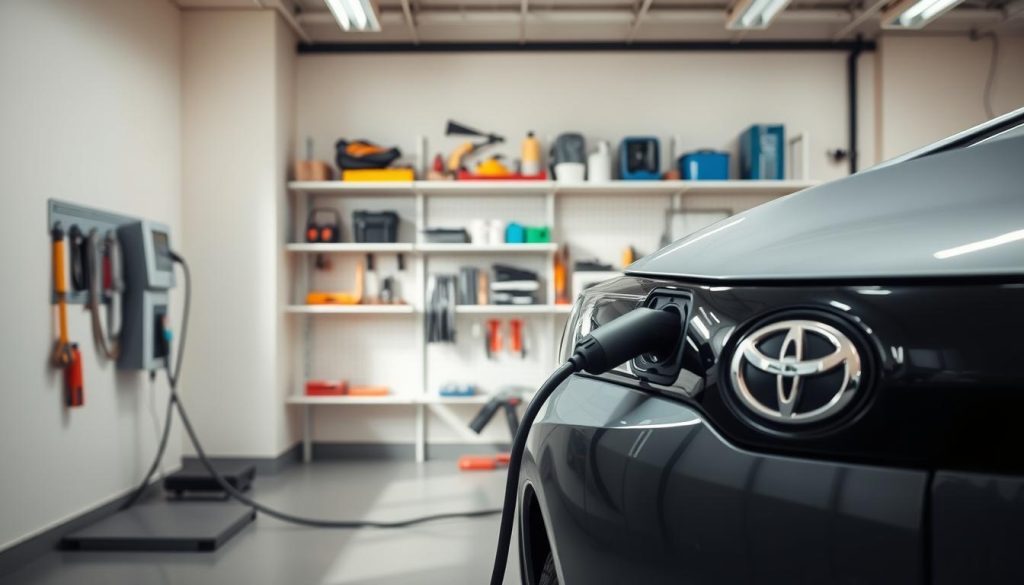
Charge regularly instead of waiting until it’s almost empty. Gentle, consistent charging is better than deep discharges and full charges.
Standard Hybrid Regenerative Braking
For non-plug-in hybrids, focus on regenerative braking. Use smooth, gradual brakes to capture more energy and turn it into electricity.
Avoid hard braking unless it’s an emergency. Gentle braking helps the regenerative system work better. It keeps your battery charged during daily use.
Avoiding Overcharging and Undercharging
Both overcharging and undercharging can harm your Toyota hybrid battery. For plug-in models, don’t leave it plugged in too long after it’s full. Also, don’t let it run out completely.
If your car will be parked for days, aim for a 50% charge. This range is best for keeping the battery healthy while it’s not in use.
Using Public Charging Stations Effectively
When using public charging, know the different levels. Level 1 uses a standard 120V outlet and is gentle but slow. Level 2 is faster and better for the battery.
Use DC fast charging only for long trips. It’s fast but can be hard on the battery. For daily charging, Level 2 is the best choice.
Temperature Management for Hybrid Batteries
Keeping your hybrid battery at the right temperature is key. It works best in a certain range. Extreme temperatures can hurt its performance and lifespan. Learning to manage these temperatures can extend your hybrid battery life and keep it running smoothly.
Effects of Extreme Heat on Battery Life
Heat is bad for hybrid batteries. It makes the chemicals inside the cells break down faster. The best temperature for a Toyota Prius battery and other Toyota hybrids is between 60-80°F (15-27°C).
When it gets hotter than this, the battery has to work harder. This makes it generate more heat. This cycle can damage the battery and shorten its life.
In the summer, protect your hybrid battery. Park in shaded spots or garages to avoid direct sunlight.
Use windshield sun shades when parking outside. They help keep the car cooler. This protects not just the battery but all the car’s electronics.
Try to drive during cooler times in the day. Early morning or evening drives are better than afternoons when it’s hottest. This helps your hybrid battery life stay healthy.
Cooling System Maintenance
Toyota hybrids have special cooling systems for the battery. These can be fans or liquid cooling.
Make sure the cooling vents are clean and open. In some Toyotas, like the Prius, these vents are behind the rear seats. Blocking them can stop airflow.
Get your battery’s cooling system checked every year before summer. A technician can make sure the fans work and the airways are clear.
Cold Weather Battery Care
Cold weather is different for your Toyota Prius battery. It doesn’t cause permanent damage like heat does. But, it does make the battery less efficient and powerful.
In winter, your hybrid might use the gasoline engine more. This is to protect the battery. It’s normal.
Keep your car in a warm garage in cold weather. For plug-in hybrids, use the pre-conditioning feature to warm up the battery and cabin before driving.
Climate Control Best Practices
Using your car’s climate control system affects the battery. Too much heating or cooling can drain the battery.
For plug-in models, warm up the interior while still plugged in. This saves battery charge for driving.
In very cold or hot weather, use seat heaters instead of the cabin heater. This uses less energy. Small changes in how you use the climate control can help your hybrid battery life a lot.
Driving Habits That Extend Toyota Hybrid Battery Life
Learning certain driving habits can make your Toyota hybrid battery last longer. How you drive every day affects your battery’s health and life. By driving smart, you can extend your Toyota hybrid battery life, save fuel, and enjoy better performance.
Efficient Acceleration and Braking
Start smoothly to avoid wearing out your hybrid system. When stopping, press the gas gently until you reach your speed. This lets the electric motor do more of the work, saving your battery.
Using the Energy Display Monitor
Your Toyota hybrid has an energy display that shows how power moves. It helps you see when you’re using electric or gasoline power. By watching this display, you can learn to use electric power more and save gas.
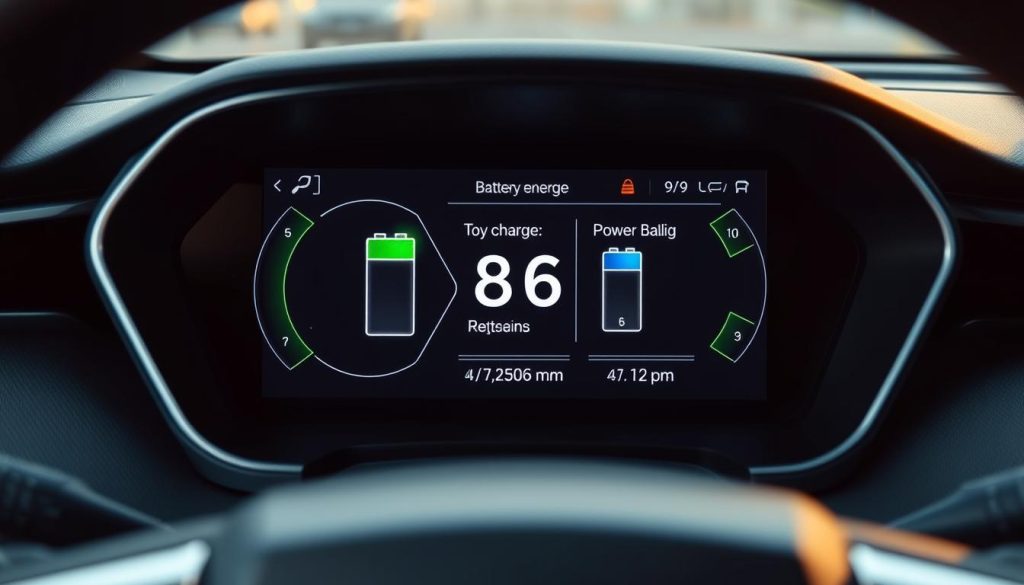
The display has different colors for electric, gasoline, and charging modes. Try to stay in the eco zone as much as you can.
Maximizing Regenerative Braking
Regenerative braking is key to keeping your hybrid battery healthy. It turns braking energy into electricity to recharge your battery. Here’s how to use it best:
- Start slowing down early before stops
- Press the gas gently before stopping
- Avoid hard braking
- Use gentle deceleration on hills
Mastering regenerative braking helps your battery last longer and saves your brakes.
Optimal Speed Ranges for Efficiency
Toyota hybrids work best at speeds between 25-50 mph. In this range, the electric motor helps a lot, saving battery and engine work. At higher speeds, the engine does more work.
Keeping a steady speed is good for your battery. Speed changes make your hybrid system work harder. Cruise control on highways keeps your speed steady and efficient.
Using EV Mode and Eco Mode Effectively
Most Toyota hybrids have special modes to help your battery:
EV Mode uses only electric power when it can. It’s best for:
- Driving under 25 mph
- Short trips in quiet areas
- Parking lots
Eco Mode makes your car more efficient. It’s great for daily driving. It slows down acceleration and uses less air conditioning to save battery.
By following these driving tips, you protect your Toyota hybrid battery. These habits can add thousands of miles to your battery’s life. They also make your driving better and save on maintenance costs.
Long-Term Storage of Toyota Hybrid Vehicles
Getting your Toyota hybrid ready for long-term storage is key. It keeps your car in top shape and ensures the battery works well when you need it. Hybrids have special batteries that need extra care when not in use.
Preparing Your Hybrid for Storage
Start by doing a quick maintenance check. Make sure all fluids are right, tires are full, and the car is clean. This helps avoid damage from dirt and grime.
Battery Charge Levels for Storage
The best charge for your Toyota Prius battery is 40-60%. This keeps the battery from breaking down too fast.
For non-plug-in hybrids, drive until the screen shows half charge. Plug-in models should be charged to about 50% before you stop using it.
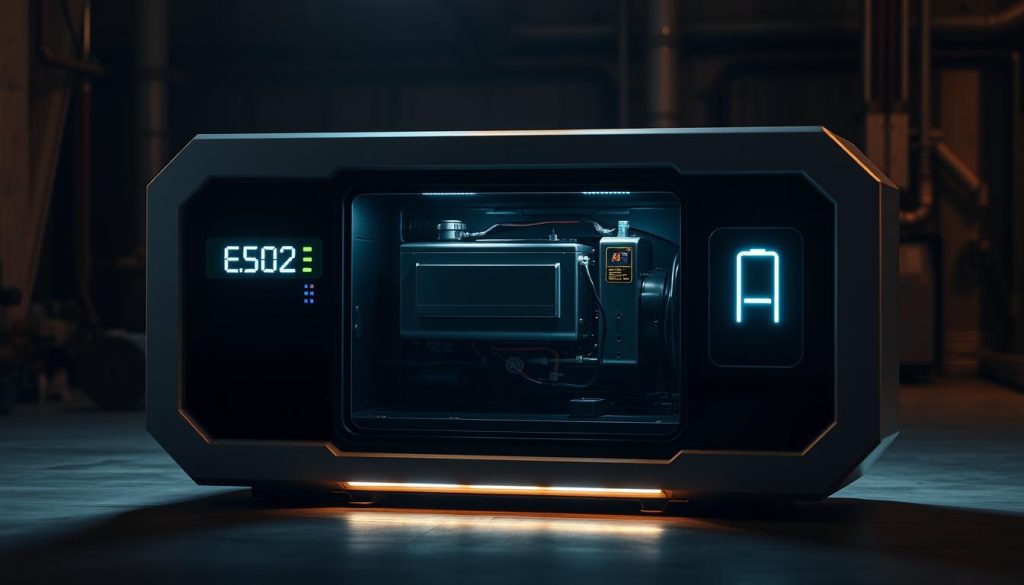
Keeping your hybrid car battery cool is important. Try to store your car in a place with a temperature between 40-70°F (4-21°C).
Heat can hurt your battery, even when the car is off. Cold can make it drain faster. If you can’t keep it cool, use a car cover to help.
Maintenance During Extended Storage Periods
If you’re storing your car for more than a month, you’ll need to do more. For three months or more, disconnect the 12V battery to avoid draining it completely.
Every 1-2 months, start the car and let it run for 30 minutes. This keeps the battery healthy and stops fluids from drying out.
Reactivating After Long-Term Storage
When you get your hybrid back, check it over carefully. Look at fluids, tire pressure, and for any damage.
Let the car finish its startup before driving. You might see less electric range at first. But it should get better as you drive more.
Toyota Hybrid Battery Warranty Information
Knowing about your Toyota hybrid battery warranty can save you a lot of money. It also gives you peace of mind. Toyota is confident in their hybrid technology and offers a top-notch warranty package.
The standard warranty covers key parts for 8 years or 100,000 miles, whichever comes first. This includes the battery pack, control module, hybrid module, and inverter. These are the heart of your hybrid system and would cost a lot to replace.
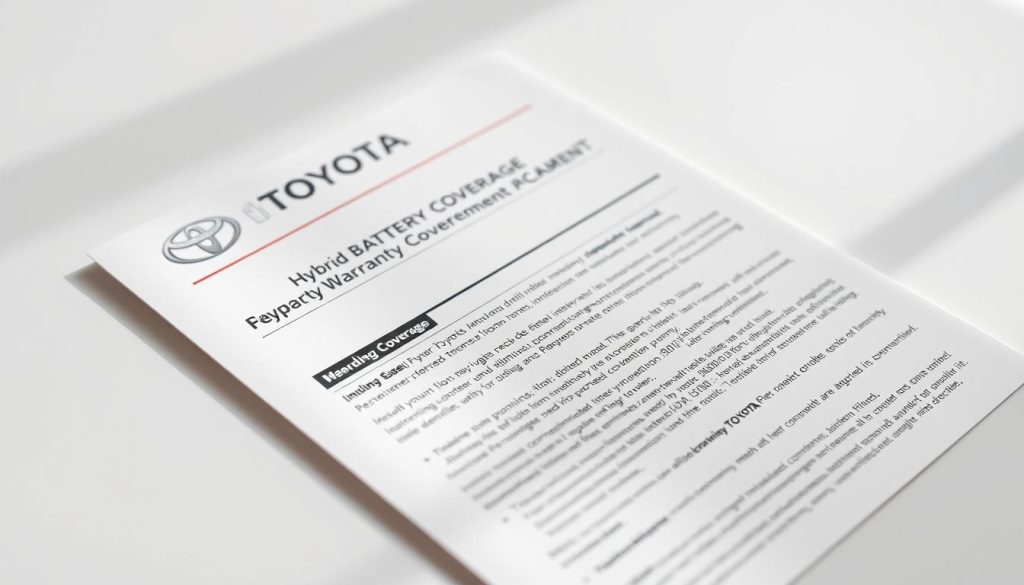
Standard Warranty Coverage by Model
Toyota’s warranty terms vary by model and location. Knowing this can help you make better choices when buying and maintaining your vehicle.
Prius Family Warranty Details
The Prius family, including the standard Prius, Prius Prime, Prius c, and Prius v, all get the same 8-year/100,000-mile warranty on hybrid parts. But, if you live in certain states with stricter emissions laws, you get even more protection.
In California, Connecticut, Maine, Massachusetts, New York, Rhode Island, and Vermont, you get a 10-year/150,000-mile warranty on hybrid batteries. This extra coverage is a big plus, especially for those who drive a lot.
Other Toyota Hybrid Models
The Camry Hybrid, RAV4 Hybrid, Highlander Hybrid, and Avalon Hybrid all have the standard 8-year/100,000-mile warranty. They also qualify for the extended 10-year/150,000-mile coverage in states with stricter emissions laws.
The Corolla Hybrid and newer models like the Venza Hybrid follow the same warranty structure. This makes it easier to compare models based on features, not warranty differences.
Extended Warranty Options
Many owners find the factory warranty enough. But, if you plan to keep your Toyota hybrid for a long time, extended protection might be a good idea.
Toyota offers several extended warranty plans through their Toyota Care Plus program. These plans vary in duration and coverage levels. Costs usually range from $1,000 to $3,000, depending on the plan and model.
Third-party warranty providers also offer extended coverage for hybrid components. They often have competitive rates. Always compare coverage details and exclusions before buying an extended warranty to ensure you’re getting a good deal.
What’s Covered and What’s Not
Knowing what your Toyota hybrid battery warranty covers and what it doesn’t can save you from surprises. The warranty covers defects in materials and workmanship under normal use conditions.
However, there are important exclusions. Damage from accidents, improper maintenance, environmental factors, or vehicle modifications is not covered. Also, normal battery capacity loss, which can reach 70-80% after 8-10 years, is considered expected degradation and isn’t covered under warranty.
| Coverage Type | What’s Included | What’s Excluded | Potential Cost Without Warranty |
|---|---|---|---|
| Standard Warranty | Battery pack, control modules, inverter | Normal capacity loss, accident damage | $3,000-$5,000+ (new OEM) |
| Extended Warranty | Same as standard with longer term | Same exclusions as standard | $1,000-$3,000 (warranty cost) |
| State-Specific Extended | 10yr/150k miles in qualifying states | Same exclusions as standard | No additional cost to owner |
| Reconditioning Option | Not covered by Toyota warranty | All reconditioning services | $1,500-$3,500 (reconditioned) |
To keep your warranty valid, keep detailed records of all maintenance. Toyota might deny warranty claims if they find improper maintenance caused the battery failure. Regular maintenance is key to avoiding battery problems and warranty issues.
If your hybrid battery fails outside of warranty, replacement can be very expensive. New OEM batteries cost between $3,000 to $5,000 plus labor. Reconditioned options might cost between $1,500 and $3,500. This shows how valuable your Toyota hybrid battery warranty is.
Troubleshooting Common Toyota Hybrid Battery Problems
Knowing how to spot common Toyota hybrid battery issues can save you money. Often, problems come from single cells, not the whole battery. With the right tools, you can figure out if it’s a small fix or a big job.
Diagnosing Battery Cell Issues
When your Toyota hybrid battery acts up, finding the cause is key. Single cell problems can seem like the whole battery is failing. A pro can find out if it’s just one cell or more.
Using OBD-II Scanners
OBD-II scanners are essential diagnostic tools for Toyota hybrid owners. Basic scanners give error codes, but hybrid scanners offer more. They show:
- Voltage variations between individual cells
- State of charge across the battery pack
- Temperature readings from various sensors
- Historical performance data
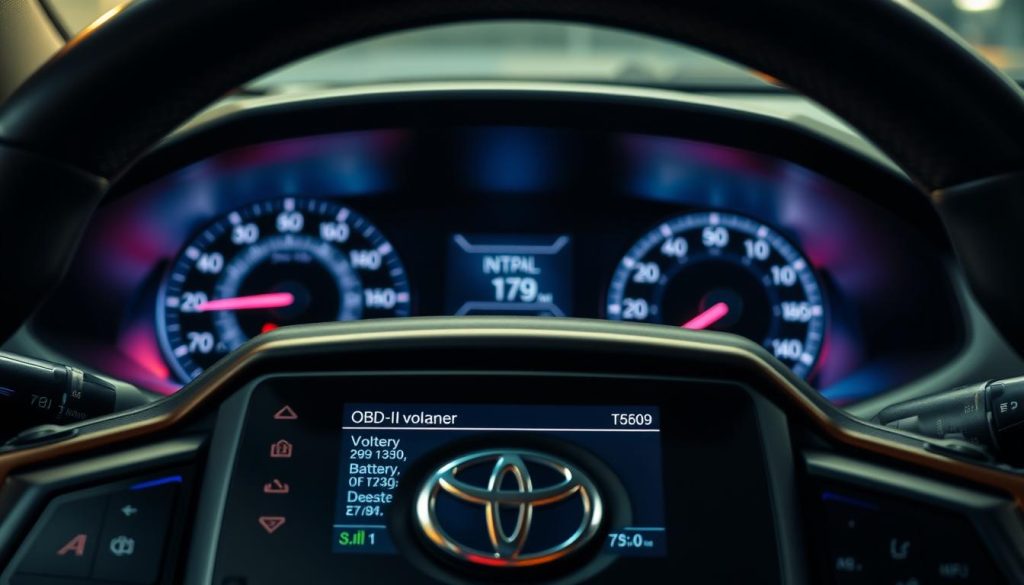
When checking your Toyota hybrid battery, watch for P0A codes. They usually mean hybrid system problems. Common codes include:
- P0A80: Replace hybrid battery pack
- P0A7F: Battery deterioration
- P0AFA: Battery cooling system problems
It’s important to understand these codes. Some mean small fixes, while others need a pro.
Addressing Cooling System Problems
The cooling system is crucial for your Toyota hybrid battery. Issues can lead to poor performance or early failure. Make sure vents are clear and fans work right.
Listen for the cooling fan during charging or heavy driving. If it’s not on when it should be, it might need fixing.
Dealing with Electrical Connection Issues
Problems with electrical connections can cause issues that seem like serious battery failure. Regular checks can stop these problems before they get worse.
Terminal Cleaning and Maintenance
When cleaning terminals, always be careful with high-voltage systems. For the 12V battery, a baking soda solution can fix many starting problems.
Voltage Testing Procedures
Testing the high-voltage system needs special tools and knowledge. But, a standard multimeter can check the 12V system. This can help find issues that affect hybrid performance.
Safety warning: Only trained technicians should work on the high-voltage battery. Trying to fix it yourself can be very dangerous.
Toyota Hybrid Battery Replacement Options
Choosing the right Toyota hybrid battery replacement is key. It’s about finding the best value without losing reliability. When your battery fails, you’ll need to make a choice that affects your car’s performance and your wallet. Making the right choice can save you a lot of money and keep your Toyota running efficiently.
Dealer Replacement vs. Independent Shops
You have two main choices for hybrid battery replacement: Toyota dealerships or independent shops. Each has its own pros and cons.
Pros and Cons of Each Option
Toyota dealerships offer skilled technicians and genuine parts. Your battery will be new or remanufactured by Toyota, ensuring top performance. Plus, dealer service won’t harm your warranty. But, it’s more expensive—up to 50% more than independent shops.
Independent shops can save you money. They use refurbished batteries that work well at lower prices. But, the quality and expertise can vary, so choosing wisely is crucial.
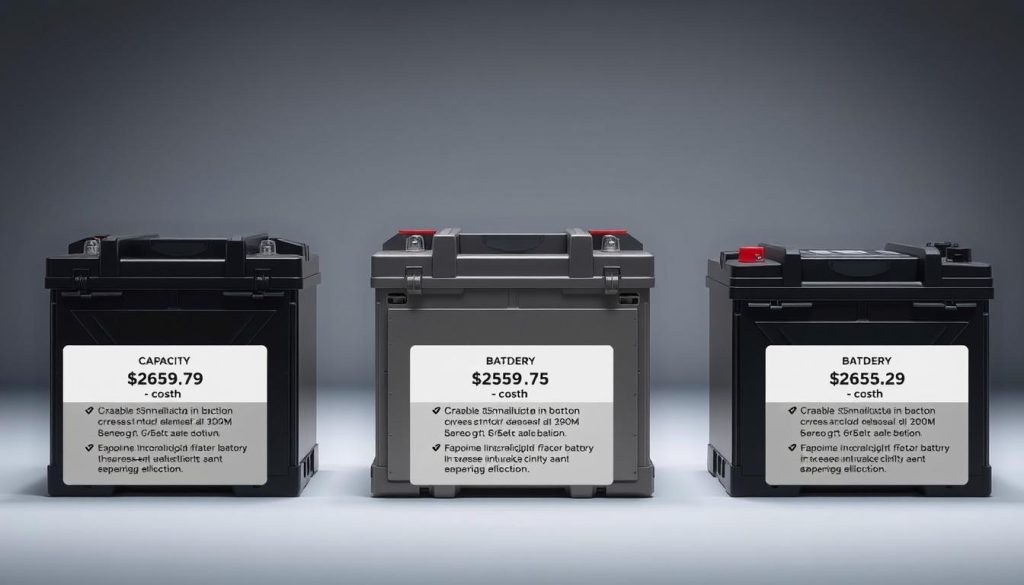
For independent shops, look for certified hybrid technicians. Check online reviews for hybrid battery replacements, not just general service. A good shop should offer a warranty, like 1-3 years on their battery replacements.
New vs. Refurbished Batteries
New OEM batteries are the most reliable and come with Toyota’s 8-year/100,000-mile warranty. They’re the best but also the most expensive hybrid battery cost.
Refurbished batteries replace only the bad cells in your pack. They cost less but might not last as long as a new one. Quality refurbished batteries usually come with 1-3 year warranties.
Cost Comparison and Considerations
The cost of replacing your battery depends on your car model and the option you choose. Knowing these costs helps you plan for this necessary expense.
Model-Specific Replacement Costs
For Prius models, new batteries cost between $3,000-$4,500, including labor. Camry and RAV4 hybrids are similar. But, bigger vehicles like the Highlander Hybrid might cost more due to their larger batteries.
Refurbished batteries from trusted shops cost between $1,500-$2,500 installed. This is about half the price of dealer replacements. It’s a good choice for older hybrid vehicles.
Insurance and Financing Options
Some warranties might cover battery replacement. Check your policy before assuming you’ll pay out of pocket. Many shops also offer financing to make the cost more manageable.
Toyota aims to recycle old hybrid batteries by 2050. This supports their goal of carbon neutrality. Proper replacement through authorized channels helps the environment too.
Hybrid Battery Reconditioning and Refurbishment
Toyota hybrid owners with battery troubles can benefit from reconditioning and refurbishment. This service extends battery life at a lower cost than replacing it. It restores degraded cells to improve performance without replacing the whole unit. This can add years to your battery’s life and save thousands of dollars compared to buying a new one.
When Reconditioning Makes Sense
Not every hybrid battery is right for reconditioning. It’s best when your battery has moderate issues but still works. You might see your fuel economy or electric-only range drop.
More frequent engine use when it should be electric-only also hints at reconditioning. Fluctuations in battery level on your dashboard often mean cell imbalance. This imbalance can be fixed with reconditioning.
Typically, Toyota hybrid batteries between 5-10 years old with moderate wear are good candidates. However, those with severe damage or thermal runaway issues are usually not fixable.
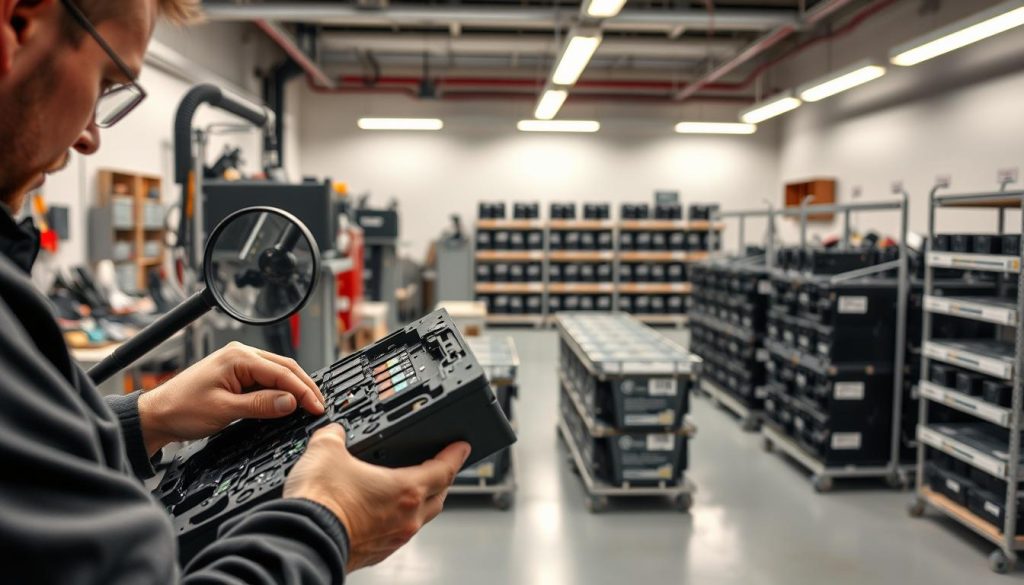
The Reconditioning Process Explained
The reconditioning process varies by service provider but follows similar steps. It starts with detailed diagnostics to find underperforming cells. Technicians use special tools to check voltage, resistance, and capacity of each cell.
Cell Balancing Techniques
Cell imbalance is a common problem. Over time, cells in your battery pack can charge and discharge differently. This imbalance forces the battery management system to limit performance to protect weak cells.
Technicians use controlled cycles to balance cells. This process, called “grid charging,” applies specific voltages to match cell performance. It leads to more consistent power and better battery function.
Capacity Restoration Methods
Reconditioning also aims to restore cell capacity. This involves applying current profiles to break down crystalline formations that limit energy storage. Some services replace weak cells while keeping most of the original pack. This approach reduces waste and cost compared to full replacement.
Quality reconditioning also includes cleaning connections, replacing cooling parts, and updating settings. This ensures the best performance.
Finding Reputable Reconditioning Services
The quality of hybrid battery reconditioning varies. Look for specialists with experience on your Toyota model. Check customer reviews and ask about warranties, which are usually 1-2 years.
Good services offer clear pricing, often between $500-$1,500. They should show before and after performance metrics to prove improvement.
While Toyota dealerships usually replace batteries, some certified shops offer reconditioning. Ask about their process and success rates before choosing.
| Consideration | Battery Reconditioning | Battery Replacement | Best For |
|---|---|---|---|
| Average Cost | $500-$1,500 | $2,000-$4,500 | Reconditioning saves 60-80% |
| Service Time | 1-3 days | Same day | Replacement for time-sensitive needs |
| Expected Longevity | 2-5 years | 8-10 years | Replacement for long-term solution |
| Environmental Impact | Low (reuses existing materials) | Moderate (requires new resources) | Reconditioning for eco-conscious owners |
| Warranty Coverage | 1-2 years typical | 3-8 years typical | Replacement for warranty coverage |
When deciding, think about how long you’ll keep your Toyota hybrid. If you plan to drive it for years, a replacement might be worth the cost. But for older vehicles or those you’ll sell soon, reconditioning is a better value for fixing issues.
Environmental Impact and Recycling of Toyota Hybrid Batteries
Toyota hybrid vehicles have a lower environmental impact thanks to battery recycling and repurposing. These cars already cut down on carbon emissions. Toyota’s battery lifecycle management makes them even more eco-friendly.
Toyota turns waste into valuable resources, aiming for carbon neutrality by 2050. Their approach shows that Toyota hybrid batteries are more than parts. They’re part of a sustainable transportation system.
Toyota’s Battery Recycling Program
When a Toyota hybrid battery’s life ends, it goes into recycling. Dealerships and service centers collect these parts carefully.
Toyota has a high 91% recovery rate for hybrid batteries. They’re working to improve this. Recycling gets back valuable materials like nickel, cobalt, and copper.
- Nickel and cobalt for new battery production
- Rare earth elements for various industrial applications
- Copper and aluminum components
- Plastic casings and insulators
This recycling reduces mining needs and saves natural resources. It’s a closed-loop system that’s good for the planet.
Environmental Benefits of Proper Disposal
Proper disposal of hybrid car batteries has big environmental wins. It keeps harmful materials from harming soil or water.
Recycling a Toyota hybrid battery cuts new battery production carbon by up to 70%. It’s a big step towards sustainability.
Toyota’s recycling also stops harmful chemicals from being released. It makes sure valuable parts don’t waste away. This supports global sustainability goals and makes hybrids even better for the environment.
Second-Life Applications for Used Batteries
Not all Toyota hybrid batteries need recycling right away. Many still have 70-80% of their original power. This power is great for less demanding uses.
Toyota has found new uses for these batteries. They can last 5-10 years longer before recycling. This makes the most of the energy already used in making them.
Home Energy Storage Solutions
Used Toyota hybrid batteries can power homes. They store energy from solar panels or act as backup power during outages.
These systems are 30-40% cheaper than new ones. A single Toyota hybrid battery can power homes for hours during an outage.
Commercial Applications
Second-life batteries also help businesses. Toyota has shown their value in several projects:
- Grid stabilization systems that store excess renewable energy
- Power management for commercial buildings to reduce peak demand charges
- An installation at Yellowstone National Park using repurposed Camry Hybrid batteries to store solar energy
- Emergency backup power systems for critical infrastructure
These uses extend battery life and support renewable energy. Hybrid owners help by recycling their batteries. This supports a network of sustainable energy solutions.
Conclusion: Maximizing Your Toyota Hybrid Battery Investment
Your Toyota hybrid battery is a big investment that needs care. By following the tips in this guide, you can make it last longer than usual. Many Toyota Prius batteries work well for over 200,000 miles with the right care.
Keeping your battery in top shape is key. This means managing extreme temperatures and driving in a way that’s good for the battery. A little effort now can save a lot of money later.
Watch for signs that something’s wrong and fix it fast. Catching problems early can stop a total battery failure. Also, getting your battery checked by a pro regularly can spot issues before they get worse.
Toyota keeps making their batteries better with each new model. They also have recycling programs to reduce waste when your battery’s done.
It doesn’t matter if you have a Prius, Camry Hybrid, or RAV4 Hybrid. The same rules apply. Keep the temperature right, use it regularly, charge it correctly, and get it checked by a pro. This way, your Toyota hybrid will keep running smoothly and efficiently for a long time.
Think of your hybrid as more than just a car. It’s a smart choice for your wallet and the planet. Taking good care of it means you’ll get the most out of it.
FAQ
How long do Toyota hybrid batteries typically last?
Toyota hybrid batteries can last a long time with the right care. They often go over 150,000-200,000 miles before needing a new one. Toyota’s hybrids are very durable, with Prius owners often keeping their cars for 15+ years.
What are the early warning signs of Toyota hybrid battery issues?
Watch for dashboard lights, like the hybrid system or check engine light. Also, look for a drop in fuel economy, power issues, and the engine running when it shouldn’t. Unusual sounds, like fan noise or clicking, are also signs.
What’s covered under Toyota’s hybrid battery warranty?
Toyota’s warranty covers hybrid parts, including the battery, for 8 years or 100,000 miles. In some states, like California, it’s 10 years or 150,000 miles. It doesn’t cover damage from accidents or improper use.
How often should I have my Toyota hybrid battery serviced?
Toyota suggests checking your hybrid system every 5,000 miles. This includes looking at the battery cooling and checking the cell voltage. Regular checks help your battery last longer and keep your warranty valid.
What’s the ideal temperature range for a Toyota hybrid battery?
Batteries work best between 60-80°F (15-27°C). Extreme temperatures, especially heat, can harm them. Keeping the battery cool is key.
What driving habits help extend Toyota hybrid battery life?
Drive smoothly and avoid sudden starts. Use regenerative braking by slowing down before stops. Keep speeds steady and use EV mode for short trips.
How should I prepare my Toyota hybrid for long-term storage?
Store with 40-60% charge. Keep it in a cool place, 40-70°F (4-21°C). For long storage, start it every 1-2 months to keep the battery healthy.
What’s the cost to replace a Toyota hybrid battery?
Replacing a Prius battery costs ,000-,500 at the dealer. Refurbished ones cost.
